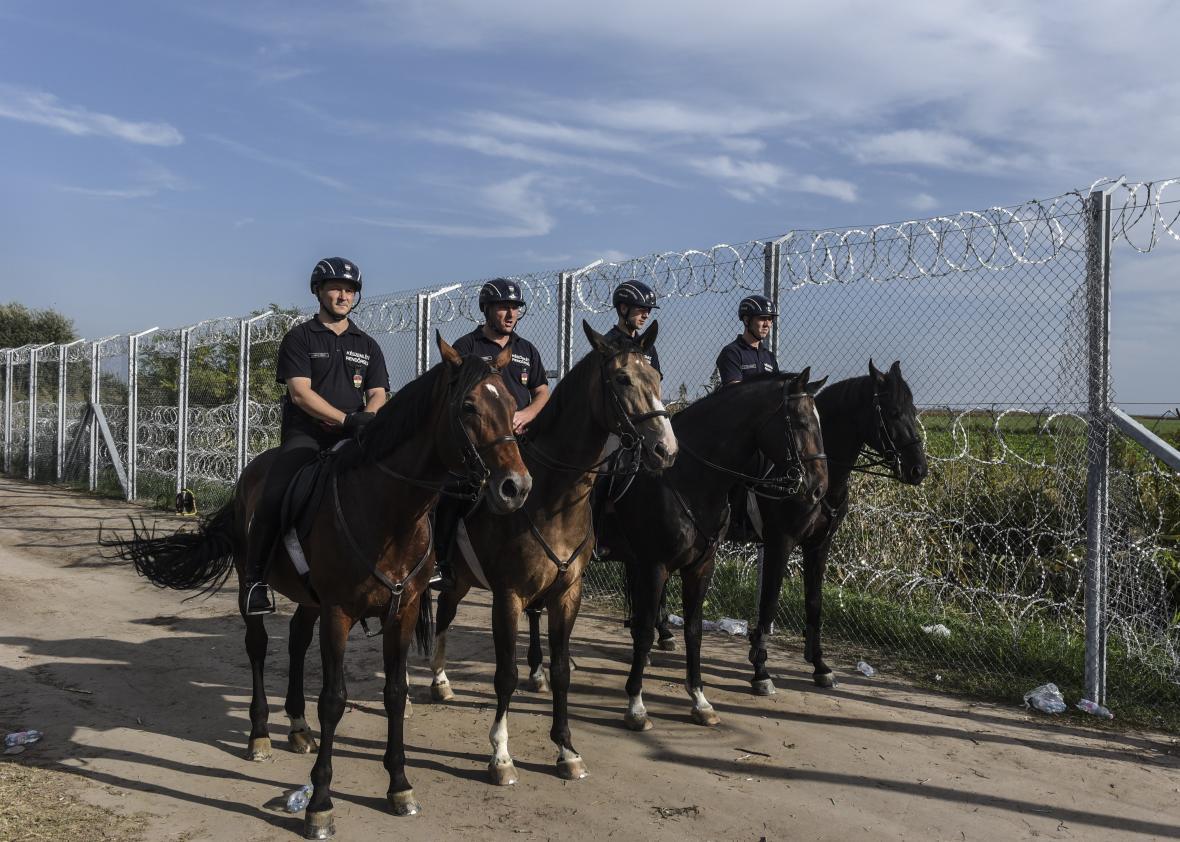Germany’s move over the weekend to impose controls on its border with Austria after taking in an unprecedented number of refugees seems designed to put pressure on other European government to take in more people fleeing from violence in the Middle East and North Africa. In particular, the relatively new EU member countries in Eastern Europe have emerged as the main opponents to accepting large numbers of refugees, widening an already stark political divide on the continent.
Hungary, Poland, Slovakia, and the Czech Republic, who all joined the EU in 2004 and are known collectively as the Visegrad Group, rejected European Commission President Jean-Claude Juncker-‘s proposal for a quota system for refugees based on a country’s size, GDP, and unemployment rate. Poland has agreed to take in 2,000 refugees over the next two year, far less than the 12,000 proposed under the EU system, but enough to provoke right-wing protests in several cities with demonstrators holding signs reading “today’s refugees, tomorrow’s terrorists.”
Slovakia has said it will take in only a few hundred refugees and only Christians, as Muslims were “not going to like it” there because of the country’s negligible Muslim population and mosques. In the Czech Republic, 94 percent of the population says the EU should return refugees to where they came from and the police have been criticized for writing numbers in marker on the arms of asylum-seekers in a grim evocation of the Holocaust. Hungary, a front-line country in the crisis due to its location, has been building a fence along its border with Serbia and Prime Minister Viktor Orban has called for the refugees to be kept out in order to “keep Europe Christian.”
So what accounts for this hostility in the countries that Donald Rumsfeld once called “new Europe”? For one thing, Eastern Europe (I’m using the term to distinguish these countries from places like Germany and Austria although “Central Europe is generally preferred.) has relatively little experience with large-scale immigration and until recently was generally considered a source of migrants rather than a destination. In Western Europe, the “Polish plumber” was the symbol of anxiety over migration long before it was the Syrian asylum-seeker. Given questions about refugees’ motives— Slovakian Prime Minister Robert Fico has suggested, in the face of most available evidence to the contrary, that the vast majority of the refugees are actually economic immigrants—many people in these countries may be wondering why they’re being lectured about taking in migrants by countries that weren’t particularly welcome to them. One populist political candidate has even suggested there’s a global conspiracy at work for “Poles to be scattered around the world” while “diverse nationalities” come to Poland. Because of the lack of previous immigration, these countries’ populations have remained relatively homogenous. While in France and Germany, the Muslim population is 7.5 percent and 5.8 percent respectively—the result of waves of migration going back decades—it’s below 0.1 percent in Poland, the Czech Republic and Hungary. (It’s a whopping 0.2 percent in Slovakia.) And as Poland’s prime minister has pointed out, the country is already coping with a large number of refugees fleeing the conflict in Ukraine.
As Gustav Gressel of the European Council on Foreign Relations notes, while Western European countries certainly have their own difficulties with anti-foreigner sentiment and with integrating immigrants, they at least have established organizations to help absorb new arrivals and they have minority groups in politics to advocate for them. This is thanks to large existing foreign-born populations, which are missing in Eastern Europe. Media outlets in Eastern European countries, meanwhile, are also less likely to have extensive coverage and analysis of events in the Middle East and Africa.
The economic difficulties of recent years have also left many Eastern Europeans increasingly cynical about European integration and resentful of being lectured to by their wealthier Western European counterparts. As the Bulgarian commentator Ivan Krastev writes, “many Eastern Europeans feel betrayed by their hope that joining the European Union would mean the beginning of prosperity and an end to crisis.” They were, he notes, promised “tourists, not refugees.”
All these factors are understandable. And no country—even Germany, definitely not the United States—is exactly accepting new arrivals without reservations. But as Paul Hockenos writes, the hostility towards those fleeing unspeakable horror and violence is disappointing to see from countries whose citizens have more than once relied on the kindness of foreigners when escaping their own periods of war and oppression.
Also in Slate, see the latest photographs from the European refugee crisis.
Read more of Slate’s coverage of the European refugee crisis.
